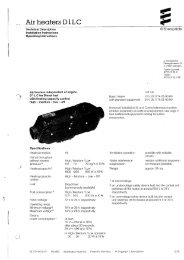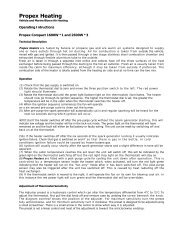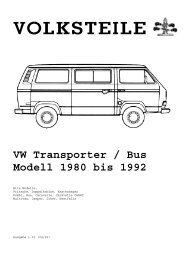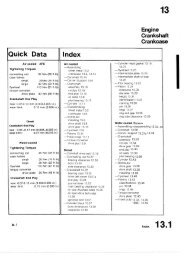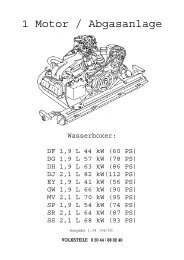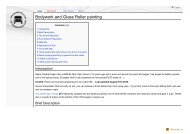RM120 - Club 80-90
RM120 - Club 80-90
RM120 - Club 80-90
Create successful ePaper yourself
Turn your PDF publications into a flip-book with our unique Google optimized e-Paper software.
locates properly in the recess in the outer cover, with<br />
the tongue engaging the slot at the bottom.<br />
It will be necessary to remove the outer cover and<br />
withdraw the extension tube before the refrigerator can be<br />
moved out o position at any time.<br />
12. 12V ELECTRICAL INSTALLATION<br />
For operation from the 12V battery in the towing vehicle,<br />
the boiler of the cooling unit is fitted with an 85 watt<br />
heating element connected to a terminal block on the<br />
back of the refrigerator (fig. 15). Before finally installing<br />
the refrigerator in the recess, the wiring for the 1 2V<br />
electrical supply should be connected to the terminal<br />
block, leaving enough slack for subsequent insertion<br />
and withdrawal of the refrigerator for servicing purposes.<br />
To prevent undue voltage drop, which would impair<br />
the performance of the cooling unit, the wiring for the<br />
12V refrigerator supply should be connected directly to<br />
the terminals of the battery in the towing vehicle and not<br />
through any of the existing wiring (which may not be<br />
capable of carrying the 7 amp load satisfactorily), and<br />
not to an auxiliary battery in the car or caravan. The wire<br />
used for connecting must be at least 2 mm 2 in crosssectional<br />
area (e.g. 28/0.30mm or 35/0.30mm), and<br />
should be kept as short as possible. The wire may be<br />
'twin' sheathed, or two singles taped together at<br />
intervals; the chassis or body of the car and caravan<br />
should not be used as a substitute for one of the wires.<br />
Polarity is not important with regard to the refrigerator, but a fuse, such as Lucas part no. 188220, 7/15 amp, must be incorporated<br />
in the supply (to the side of the battery not connected to the chassis) as near to the battery as possible. A good quality fuse holder<br />
should be used, with adequate size contacts to carry the 7 amp load without undue resistance.<br />
For connection between the car and the caravan, a suitable size weather-proof plug and socket will be necessary and<br />
sufficient slack cable allowed for the normal manoeuvring of the car and caravan. (As the pins of the existing trailer plug and<br />
socket will normally be taken up with lights and other electrical equipment, it will probably be necessary to install an<br />
additional trailer plug and socket and use two of its pins for the refrigerator supply). A suitable switch or plug and socket<br />
may also be installed inside the caravan so that the refrigerator can conveniently be disconnected from the 12V supply when<br />
required.<br />
When operating on 12 volts, the refrigerator has a relatively high current consumption and it is only intended to be used<br />
by this method of operation whilst the engine is running and charging the battery, and for short stops, otherwise the battery<br />
may become discharged to a point where it will not re-start the car engine. 12 volt operation is not thermostatically controlled<br />
and the 85 watt heating element is 'on' all the time the refrigerator is connected to the 12V supply.<br />
Note: To minimise the possibility of a drained battery due to the refrigerator being inadvertently left operating when the<br />
engine is at rest, a suitable relay device (e.g. Lucas No. 6RA) may be fitted in the car, in circuit with the ignition switch, so<br />
that when the engine is switched off, the refrigerator is switched off.<br />
13. GAS CONNECTION<br />
It is recommended that the gas pipe feeding the refrigerator is run underneath the caravan and is so arranged that it is possible to<br />
turn off the supply to all appliances other than the refrigerator, when they are not required. The supply pipe should preferably be of<br />
copper; if any other material is used, it must be of a type approved for use with continuously operating bottled gas appliances, and<br />
have threaded connections throughout. Push-on connections must not be used. We do not recommend the use of "rubber" type<br />
flexible tubing for connecting permanently operating appliances of this type in the United Kingdom.<br />
All connectors etc. should be of a type specifically designed for the type and diameter of the connection pipe used, and screwed<br />
joints should be sealed with a jointing compound approved for use with bottled gas.<br />
The gas supply pipe should be connected to the angled inlet adaptor underneath the refrigerator on the left-hand side of the gas<br />
thermostat. The adaptor will accept a 1/8" B.S.P. male thread.<br />
Note:- In the United Kingdom, 'Wade' Couplings are available from Caravan Dealers and Gas Fitting Suppliers in suitable sizes<br />
to connect the refrigerator to any of the usual sizes of metal tubing. For example, Wade Coupling No. 7061 has a union on the inlet<br />
to take 3/16" o.d. metal tubing, and has a 1/8" B.S.P. male thread on the outlet which will fit the thread on the refrigerator gas<br />
control. However, some dealers may not stock this particular fitting and Wade Coupling No. 1061 can be used as a substitute. A<br />
further alternative is Wade Coupling No. 1041 which has union nuts and olives at both ends; - by removing and discarding the nut<br />
and olive at one end, it can be used in place of the types 7061 and 1061 described above.<br />
When fitting any of these couplings, the thread should be smeared with an approved sealing compound before screwing it into the<br />
refrigerator inlet adaptor.<br />
In making the connection to the refrigerator, a union gas cock of an approved type for bottled-gas must be incorporated in the<br />
supply line in a position which is readily accessible to the user. For eventual servicing purposes, the union should be on the outlet<br />
side of the cock and the pipework should be positioned so as not to prevent the refrigerator from being withdrawn easily.<br />
In most cases, the union cock is likely to be in a cupboard to one side of the refrigerator, in which case an opening will need to be<br />
made in the side wall of the cupboard sufficiently large to make the gas connection, or to retrieve the end of a piece of metal gas<br />
pipe connected to the refrigerator inlet before placing the refrigerator in the recess in order to connect it to the supply pipe or gas<br />
cock in the cupboard.<br />
After the refrigerator has been connected, all accessible connections should be checked for soundness by applying a soap/ water<br />
solution over them and watching for bubbles with, of course, the gas-bottle and any gas cocks in the line, turned on.<br />
6



